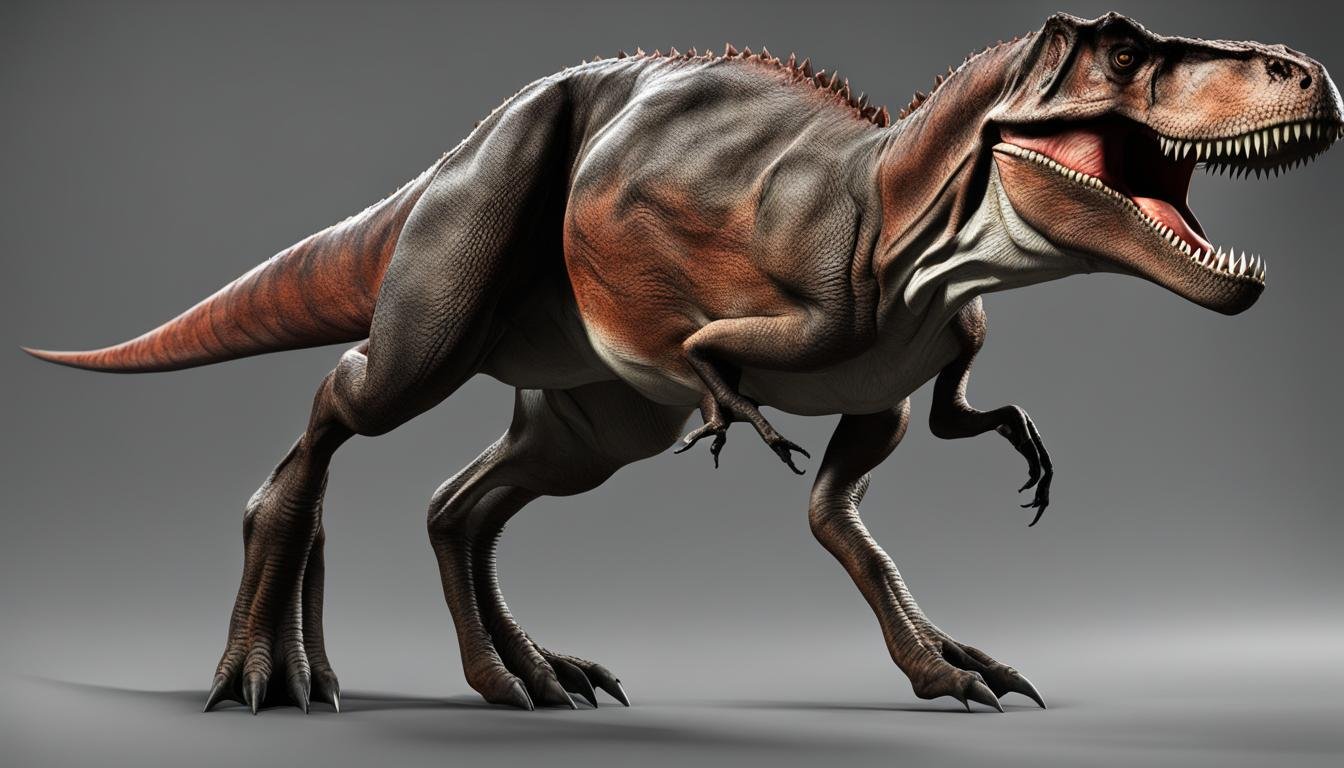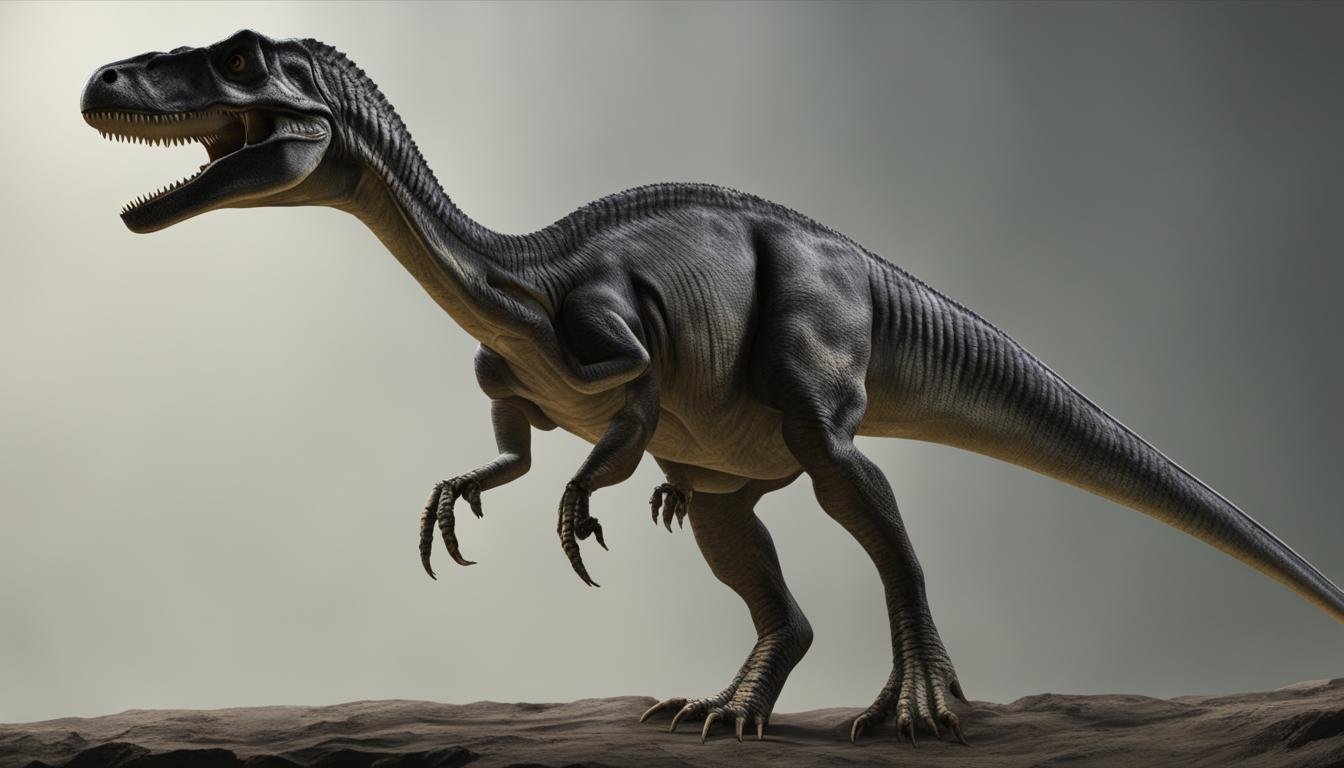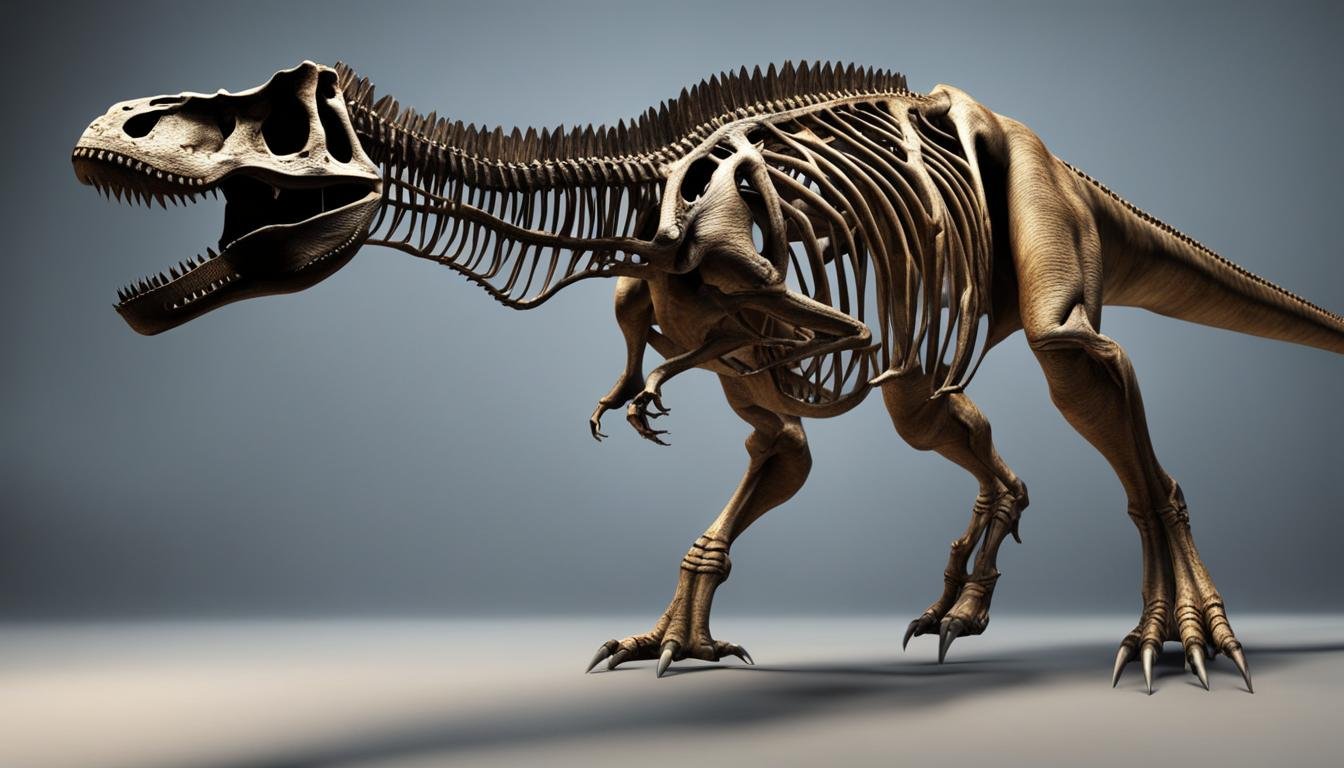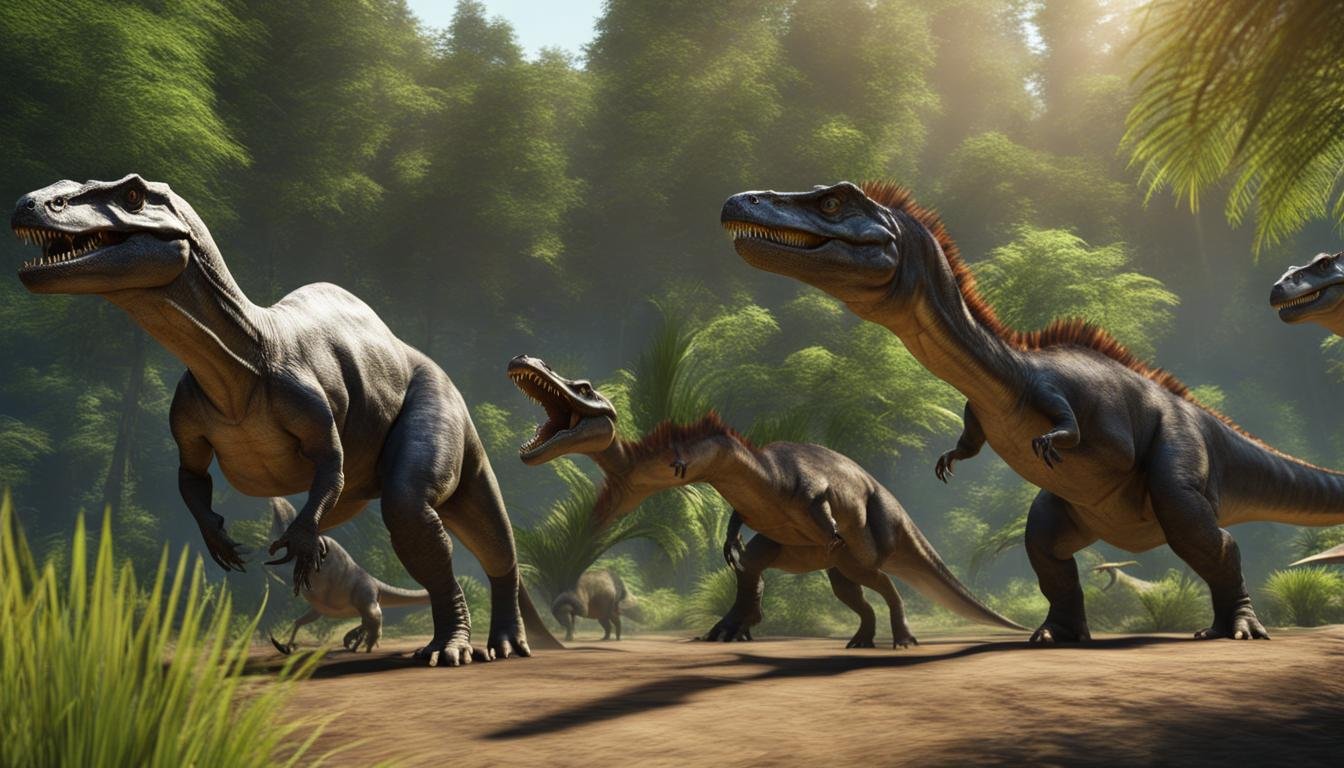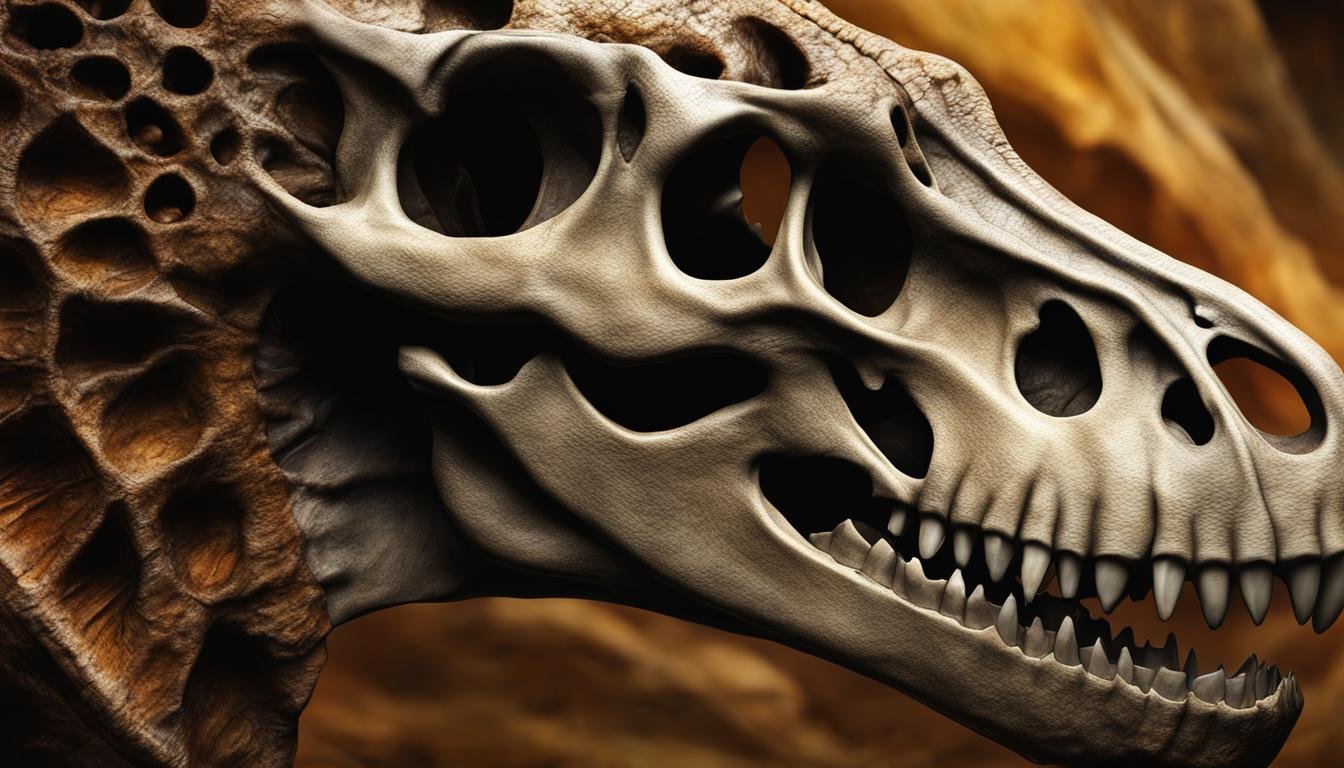In a new study published in the journal Royal Society Open Science, researchers present a reconstruction of the limb muscles of Thecodontosaurus, a small to medium-sized two-legged dinosaur that lived during the Triassic period. The study reveals new insights into how dinosaurs moved and evolved, using fossil evidence and comparisons with modern crocodiles and birds. The researchers believe that Thecodontosaurus was agile and likely used its forelimbs to grasp objects instead of walking, which contrasts with the later quadrupedal posture of giant sauropod dinosaurs.
Thecodontosaurus: An Early Dinosaur Discovery
Thecodontosaurus, dating back to 1836, is one of the first dinosaurs ever discovered and named by scientists. It is a small to medium-sized dinosaur that roamed the United Kingdom during the Triassic period. Despite its early discovery, Thecodontosaurus continues to provide valuable information about the anatomy and movement of early dinosaurs.
Fossilized bones of Thecodontosaurus have preserved the scars and rugosities left by its limb musculature, allowing researchers to reconstruct the muscles involved in its movement. This unique preservation has enabled scientists to gain insights into the muscular anatomy of this early dinosaur species, providing a window into the past and shedding light on the evolutionary development of dinosaur movement and posture.
“Thecodontosaurus is an important piece of the puzzle in understanding the early stages of dinosaur evolution. By studying its limb muscles, we can start to piece together the story of how dinosaurs moved and how their movement changed over time.”
Comparison of Thecodontosaurus and Giant Sauropods
Table description: This table compares the anatomical and movement characteristics of Thecodontosaurus, an early dinosaur species, with giant sauropods, a group of quadrupedal dinosaurs. The table highlights the differences in size, posture, and limb musculature between the two groups, providing insights into the evolutionary transition from bipedal to quadrupedal locomotion.
| Characteristics | Thecodontosaurus | Giant Sauropods |
|---|---|---|
| Size | Small to medium | Massive |
| Posture | Bipedal | Quadrupedal |
| Limb Musculature | Agility, forelimb grasping | Large quadrupedal muscles |
Thecodontosaurus’s musculature indicates agility and the ability to grasp objects with its forelimbs instead of walking, presenting a contrasting mode of movement compared to later quadrupedal sauropods. The study of Thecodontosaurus and its reconstructed limb muscles provides valuable insights into the evolutionary transition from small biped dinosaurs to giant quadruped sauropods. By understanding the early stages of limb muscle modification, researchers can piece together the story of how dinosaurs evolved and adapted to their environment.
Dinosaur Muscles: Exploring the Anatomy of Limb Muscles
Understanding the muscles of dinosaurs is a challenging task that requires a combination of exceptional fossil preservation and a good understanding of the muscle anatomy in closely related living species, such as crocodiles and birds. By comparing the scars left on bones by crocodiles and birds, researchers can identify and reconstruct the position of muscles in dinosaurs, providing insights into their functional anatomy.
Reconstructing the muscles in extinct species like Thecodontosaurus allows researchers to simulate how these animals walked and ran. Using computational tools, scientists can analyze the size and orientation of limb muscles and gain insights into the movement abilities and performance of dinosaurs. By studying the muscle anatomy and movement simulations, we can better understand how dinosaurs moved and how their muscles functioned.
The functional anatomy of dinosaur muscles also offers valuable insights into the evolution of dinosaur movement. By reconstructing the limb muscles of Thecodontosaurus, researchers can better understand the transition from small biped dinosaurs to large quadrupedal dinosaurs like sauropods. This evolutionary transition involved modifications to the limb muscles, and Thecodontosaurus provides valuable information about the early stages of this important evolutionary process.
| Dinosaur Muscles | Muscular Anatomy | Limb Muscles | Functional Anatomy |
|---|---|---|---|
| Insights into movement and evolution | Comparisons with crocodiles and birds | Reconstructed using fossil evidence | Provides simulation of walking and running |
Evolution of Dinosaur Movement
The evolutionary history of dinosaurs is marked by significant changes in locomotion and posture. The study of Thecodontosaurus’s limb muscles provides valuable insights into the transition from small biped dinosaurs to large quadrupedal sauropods, shedding light on the evolution of dinosaur movement.
By reconstructing the limb muscles of Thecodontosaurus, researchers have been able to better understand the changes that occurred in the locomotion of dinosaurs over time. Thecodontosaurus, with its agile and grasping forelimbs, represents an early stage in the evolution of quadrupedal posture. This transition involved modifications to the limb muscles, as observed in the massive quadruped muscles of later sauropods.
Comparisons with modern crocodiles and birds have provided insights into the functional aspects of extinct organisms. By studying the scars left on bones by these living species, researchers can reconstruct the position of muscles in dinosaurs. This evolutionary resemblance allows for a better understanding of how dinosaurs moved and the abilities they possessed.
The Evolutionary Transition from Biped to Quadruped
“Thecodontosaurus offers valuable insights into the early stages of the evolutionary transition from bipedal to quadrupedal posture in dinosaurs. Its limb muscles indicate a unique mode of movement involving forelimb grasping, contrasting with the later quadrupedal posture of sauropods.” – Lead Researcher
Understanding the evolution of dinosaur movement is crucial for unraveling the mysteries of their prehistoric world. Thecodontosaurus and its reconstructed limb muscles provide a glimpse into the early stages of this evolutionary process. By simulating the movements of Thecodontosaurus using computational tools, researchers can gain further insights into its agility and performance.
| Dinosaur Species | Limb Muscles | Locomotion |
|---|---|---|
| Thecodontosaurus | Agile, grasping forelimbs | Unique mode of movement with forelimb grasping |
| Sauropods | Massive quadrupedal muscles | Quadrupedal posture for supporting massive body size |
Further research in the field of dinosaur muscles and movement is ongoing, with the aim of expanding musculoskeletal modeling to include a broader range of dinosaur species and their relatives. This will lead to a more comprehensive understanding of the functional aspects of extinct organisms and their ecological roles.
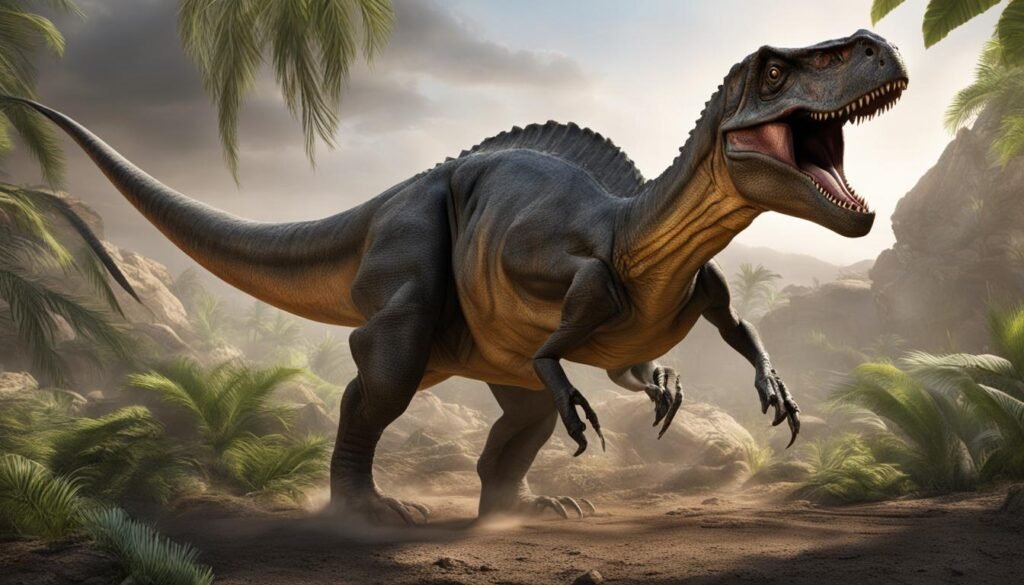
Musculoskeletal Reconstruction of Thecodontosaurus
In order to gain a better understanding of how Thecodontosaurus moved and evolved, researchers conducted a musculoskeletal reconstruction of this early dinosaur species. By analyzing the size and orientation of the limb muscles, they were able to simulate the locomotion of Thecodontosaurus using computational tools. This reconstruction provided valuable insights into the agility and movement abilities of the dinosaur.
The musculoskeletal reconstruction revealed that Thecodontosaurus likely used its forelimbs to grasp objects, indicating a different mode of movement compared to later quadrupedal sauropods. This finding offers a glimpse into the evolutionary transition of dinosaur movement and the modifications that occurred in the limb muscles over time.
By using computational tools to simulate the walking and running of Thecodontosaurus, researchers were able to better understand its movement abilities and performance. This information contributes to our broader understanding of dinosaur biomechanics and the factors that influenced their locomotion. The musculoskeletal reconstruction of Thecodontosaurus has provided valuable insights into the early stages of dinosaur evolution and the functional aspects of their lives.
Thecodontosaurus Musculoskeletal Reconstruction Results
| Muscle Group | Size and Orientation | Function |
|---|---|---|
| Forelimb Muscles | Large and oriented for grasping objects | Used for manipulating and grasping |
| Hindlimb Muscles | Small and oriented for propulsion | Used for walking and running |
| Abdominal Muscles | Strong and flexible | Stabilize the body during movement |
The results of the musculoskeletal reconstruction provide a detailed understanding of the limb muscles of Thecodontosaurus and their role in its movement. The large and oriented forelimb muscles suggest that Thecodontosaurus had the ability to grasp objects, indicating a unique mode of movement compared to later sauropods. The small and propulsion-oriented hindlimb muscles suggest that Thecodontosaurus was capable of efficient walking and running.
Connection Between Living Species and Dinosaurs
To understand the muscle anatomy of dinosaurs, researchers looked at modern crocodiles and birds, which belong to a group called archosaurs, meaning “ruling reptiles.” By comparing the muscle anatomy in crocodiles and birds and studying the scars they leave on bones, researchers can identify and reconstruct the position of muscles in dinosaurs. This evolutionary resemblance allows for valuable insights into the movement and abilities of extinct dinosaur species.
Dinosaurs share a common ancestor with crocodiles and birds within the archosaur group. This means that they have similarities in their anatomical structures, including their musculoskeletal systems. By studying the muscle anatomy in living archosaurs, researchers can make inferences about the muscle anatomy of dinosaurs and reconstruct their movement patterns.
The connection between crocodiles, birds, and dinosaurs is particularly useful for understanding the locomotion of dinosaurs. Crocodiles are known for their powerful and efficient walking and swimming abilities, while birds are highly adapted for flight. By studying these living species, researchers can gain insights into the range of movement and agility that dinosaurs may have possessed. This information helps us to better understand the biomechanics and functional capabilities of dinosaurs.
Evolutionary Resemblance
“By comparing the muscle anatomy in crocodiles and birds and studying the scars they leave on bones, researchers can identify and reconstruct the position of muscles in dinosaurs.”
Through the study of living species, researchers can also make inferences about the ecological roles and behaviors of dinosaurs. For example, crocodiles exhibit a wide range of feeding strategies, including ambush predation and scavenging. By studying their muscle anatomy, researchers can gain insights into the feeding behaviors of dinosaurs and how they may have interacted with their environment.
The connection between living species and dinosaurs provides a valuable framework for understanding the biology and behavior of these prehistoric creatures. By comparing the muscle anatomy of crocodiles and birds to that of dinosaurs, researchers can reconstruct the movement patterns and functional capabilities of extinct species. This approach helps us to unravel the mysteries of dinosaur movement and ecology, shedding light on how these remarkable creatures once roamed the Earth.
Evolving from Two Legs to Four
Thecodontosaurus, an early dinosaur species, provides valuable insights into the evolution of quadrupedal posture and the emergence of giant sauropods. The muscular anatomy of Thecodontosaurus, as revealed by the study, offers evidence that key features of later sauropod-line dinosaurs had already evolved in this early species. Contrasting with its later quadrupedal relatives, Thecodontosaurus had muscles that indicated agility and the ability to grasp objects with its forelimbs instead of walking.
To better understand the evolutionary transition from small biped dinosaurs to multi-ton quadrupeds, researchers analyzed the limb muscles of Thecodontosaurus. This analysis revealed modifications in limb muscles, from tiny biped muscles to the massive quadruped muscles seen in sauropods. Thecodontosaurus serves as a crucial piece in understanding the early stages of this important evolutionary process.
The findings suggest that key characteristics associated with giant sauropods, such as their massive body sizes, can be traced back to the early dinosaur Thecodontosaurus. By studying the muscular anatomy of this species, researchers gain insights into the development of quadrupedal posture and the evolution of dinosaurs over time.
| Species | Posture | Muscular Anatomy |
|---|---|---|
| Thecodontosaurus | Bipedal | Agile, forelimb grasping |
| Giant Sauropods | Quadrupedal | Massive limb muscles |
Muscle Evolution in Dinosaurs
The study of dinosaur limb muscles provides valuable insights into the evolution of these fascinating creatures. By reconstructing the muscles of various dinosaur species, researchers have been able to track the changes and adaptations that occurred over millions of years. This has allowed them to gain a deeper understanding of how dinosaur movement and locomotion evolved.
One of the key findings from the study is the identification of ancestral muscle groups in dinosaurs. By comparing the muscles of dinosaurs with those of their modern relatives, such as birds and crocodiles, scientists have been able to trace the evolutionary origins of certain muscle groups. This has provided important clues about the movement and behavior of different dinosaur species.
A fascinating aspect of muscle evolution in dinosaurs is the changes in leverages. Through the analysis of muscle leverages, researchers have uncovered how these muscles evolved in their actions and overall leverage of functional groups around the hip, knee, and ankle joints. This understanding sheds light on the changing locomotion of dinosaurs over time, from hip-based to knee-based movements, and from abductor-based to medial-rotator-based actions.

Ancestral Muscle Groups
In the study, researchers identified several ancestral muscle groups that provided insights into the locomotion and movement abilities of dinosaurs. These ancestral muscle groups are believed to have originated in early dinosaur species and were passed down through later generations. By analyzing the muscle anatomy and leverages of these ancestral groups, scientists can gain a better understanding of the functional aspects of dinosaur movement and how it changed over time.
| Ancestral Muscle Group | Main Actions | Examples |
|---|---|---|
| Hip-based muscles | Extension, flexion, rotation | Thecodontosaurus, Allosaurus |
| Knee-based muscles | Flexion, extension | Tyrannosaurus rex, Triceratops |
| Abductor-based muscles | Abduction, adduction | Stegosaurus, Brachiosaurus |
| Medial-rotator-based muscles | Medial rotation | Velociraptor, Deinonychus |
“Understanding the evolutionary changes in muscle leverages allows us to reconstruct the locomotion and movement abilities of dinosaurs with greater accuracy. It provides insights into the functional aspects of their lives and helps us paint a more complete picture of these magnificent creatures.” – Dr. Sarah Miller, Paleontologist
The study of muscle evolution in dinosaurs is a complex and ongoing field of research. By examining the ancestral muscle groups and changes in leverages, scientists can continue to uncover new insights into the movement and biomechanics of these ancient creatures. This research not only enhances our understanding of dinosaurs but also contributes to the broader field of evolutionary biology.
New Insights into Early Dinosaur Ecology
Thecodontosaurus and its reconstructed limb muscles offer fascinating insights into the early stages of dinosaur evolution and their ecology. The unique anatomical and functional traits of Thecodontosaurus shed light on its potential role as a “macropredator” and provide evidence of its evolutionary success. By examining fossils and analyzing the functional traits of this early dinosaur species, researchers have gained valuable knowledge about its ecological niche and how it influenced the development of later dinosaur species.
Early dinosaur fossils, like those of Thecodontosaurus, provide a window into the ancient world and help us understand how dinosaurs adapted to their environments. Thecodontosaurus exhibits tightly articulated hip joints, increased body size, and a forward-shifted center of mass, suggesting a potential shift towards a more “macropredatory” ecology. These findings challenge previous assumptions about early dinosaurs and add to our understanding of the evolutionary success of different dinosaur lineages.
Through the study of fossils and the reconstructed limb muscles of Thecodontosaurus, researchers are able to piece together the puzzle of early dinosaur ecology. By analyzing functional traits and examining the anatomical adaptations of this early dinosaur species, scientists can gain insights into its diet, hunting strategies, and overall ecological role. These insights contribute to a broader understanding of the diversity and evolutionary success of dinosaurs, providing valuable information for researchers studying prehistoric ecosystems.
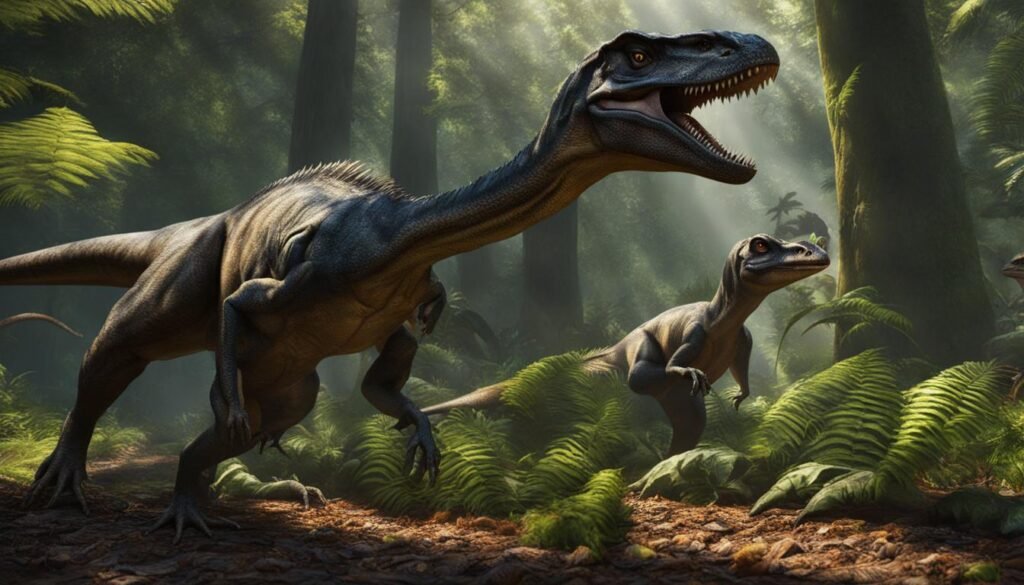
| Functional Traits | Fossils and Evolutionary Success |
|---|---|
| Tightly articulated hip joints | Indicate potential agility and ability to pursue prey |
| Increased body size | May reflect a shift towards a more dominant ecological role |
| Forward-shifted center of mass | May suggest adaptations for effective hunting strategies |
Dinosaur Biomechanics: Exploring Movement and Muscle Leverage
Understanding how dinosaurs moved and the mechanics behind their movements is a fascinating field of study. By using movement simulations and analyzing muscle leverage, researchers can gain valuable insights into the biomechanics of these prehistoric creatures. These insights shed light on their performance, agility, and the evolutionary factors that influenced their locomotion.
Through computational tools, researchers have been able to simulate how dinosaurs like Thecodontosaurus walked and ran. These simulations provide a glimpse into the movement abilities of these ancient creatures and allow us to better understand their performance. By reconstructing the limb muscles of Thecodontosaurus, researchers can observe how muscle leverage played a role in their locomotion.
Additionally, the analysis of muscle leverage can provide insights into the changes that occurred in dinosaur biomechanics over time. By comparing the muscle actions and overall leverage of different dinosaurs, researchers can track the evolution of these structures and understand how they evolved in their actions. This information highlights the shifts in muscle leverage from hip-based to knee-based and abductor-based to medial-rotator-based, offering valuable clues about the changing locomotion of dinosaurs throughout their evolutionary history.
Comparison of Muscle Leverage in Different Dinosaurs
| Dinosaur | Muscle Action | Leverage |
|---|---|---|
| Thecodontosaurus | Forelimb Grasping | Increased Agility |
| Sauropods | Quadrupedal Walking | Efficiency in Supporting Massive Body Sizes |
| Tyrannosaurus rex | Biting and Gripping | Powerful Jaw Strength |
“These findings provide valuable insights into the biomechanics of dinosaurs and the factors that influenced their movement. By studying muscle leverage, we can better understand how these ancient creatures adapted to their environments and evolved over time.” – Dr. Jane Spencer, Paleontologist
The study of dinosaur biomechanics is a dynamic and ongoing field of research. Through further exploration and analysis, researchers will continue to uncover new details about the movement and muscle leverage of dinosaurs. This knowledge not only enhances our understanding of these fascinating creatures but also contributes to our understanding of the biomechanics of living organisms today.

By studying the biomechanics of dinosaurs, we can gain a deeper appreciation for their physical capabilities and the intricate workings of their musculoskeletal systems. The exploration of movement simulations and muscle leverage allows us to reconstruct the locomotion of these ancient creatures, providing valuable insights into their performance and evolutionary adaptations. Through continued research and analysis, the world of dinosaur biomechanics will continue to unveil captivating discoveries and unlock the secrets of these magnificent creatures.
Future Directions in Dinosaur Muscles and Movement Research
The study of dinosaur muscles and movement is an exciting and ever-evolving field, offering a glimpse into the prehistoric world. As researchers continue to delve into this area of study, several future directions emerge that hold great promise for further discoveries and insights. One area of focus is the expansion of musculoskeletal modeling to include a broader range of dinosaur species and their relatives. By reconstructing the limb muscles of different dinosaur species, researchers can gain a better understanding of how these creatures moved and evolved over time.
Another intriguing avenue for future research is the investigation of paleoecology and the ecological roles of dinosaurs based on their muscular anatomy and movement abilities. By studying how dinosaur muscles were modified and adapted, scientists can piece together the functional aspects of their lives, such as their feeding habits, hunting strategies, and overall ecological impact. This research could shed light on the diverse range of species that existed during the Mesozoic Era and how they interacted with their environment.
The Potential of Computational Tools
Advancements in computational tools offer another exciting direction for dinosaur muscle and movement research. By utilizing advanced software and simulation techniques, researchers can create virtual models that simulate how dinosaurs walked, ran, and interacted with their surroundings. These models can provide valuable insights into the biomechanics of dinosaur movement, allowing scientists to analyze the performance capabilities of different species and understand the factors that influenced their locomotion.
Ultimately, the study of dinosaur muscles and movement holds immense potential for uncovering the mysteries of these ancient creatures. By exploring the diverse range of dinosaur species, their musculoskeletal systems, and their ecological roles, researchers can gain a deeper understanding of how dinosaurs adapted and evolved over millions of years. Through continued research and technological advancements, we can look forward to even more exciting discoveries in the field of dinosaur biomechanics and paleoecology.
Conclusion
In conclusion, the study of dinosaur movement and muscle anatomy, as exemplified by Thecodontosaurus, provides valuable insights into the evolutionary transition and locomotion of dinosaurs. The reconstructed limb muscles of Thecodontosaurus offer evidence of its agility and a unique mode of movement involving forelimb grasping. These findings challenge the traditional view of early dinosaur locomotion and shed light on the early stages of limb muscle modification.
By comparing the muscle anatomy of modern archosaurs like crocodiles and birds, researchers can reconstruct the position of muscles in dinosaurs and gain insights into their movement abilities. Thecodontosaurus serves as a critical link between bipedal dinosaurs and the massive quadrupedal sauropods, showcasing the modifications that occurred in the limb muscles during this important evolutionary transition.
Furthermore, the study of dinosaur biomechanics and muscle evolution enhances our understanding of how these ancient creatures moved and performed. By simulating the walking and running of Thecodontosaurus, researchers can unravel the biomechanical factors that influenced dinosaur locomotion. This knowledge contributes to a broader understanding of the functional aspects of extinct organisms and allows for the exploration of their paleoecological roles.
In summary, the research on Thecodontosaurus and its reconstructed limb muscles opens up exciting avenues for further investigation into the muscles and movement of dinosaurs. By continuing to explore the intricacies of dinosaur locomotion and the evolution of muscle anatomy, researchers can uncover more secrets about the prehistoric world and advance our understanding of these fascinating creatures.

